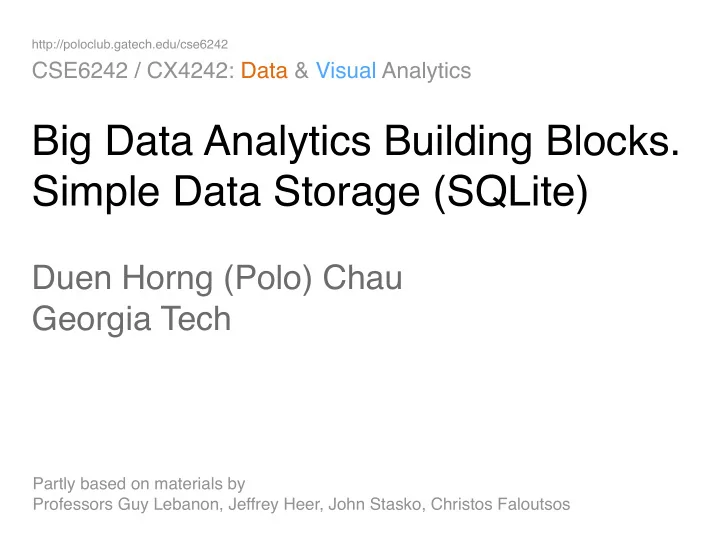

http://poloclub.gatech.edu/cse6242 CSE6242 / CX4242: Data & Visual Analytics Big Data Analytics Building Blocks. Simple Data Storage (SQLite) Duen Horng (Polo) Chau Georgia Tech Partly based on materials by Professors Guy Lebanon, Jeffrey Heer, John Stasko, Christos Faloutsos
What is Data & Visual Analytics? 2
What is Data & Visual Analytics? No formal definition! 2
What is Data & Visual Analytics? No formal definition! Polo’s definition: the interdisciplinary science of combining computation techniques and interactive visualization to transform and model data to aid discovery, decision making, etc. 2
What are the “ingredients”? 3
What are the “ingredients”? Need to worry (a lot) about: storage, complex system design, scalability of algorithms, visualization techniques, interaction techniques, statistical tests, etc. Used to be “simpler” before this big data era. Why? 3
What is big data ? Why care?
(Fall’14) What is big data ? Why care? • Many companies ’ businesses are based on big data (Google, Facebook, Amazon, Apple, Symantec, LinkedIn, and many more) • Web search • Rank webpages (PageRank algorithm) • Predict what you’re going to type • Advertisement (e.g., on Facebook) • Infer users’ interest; show relevant ads • Infer what you like, based on what your friends like • Recommendation systems (e.g., Netflix, Pandora, Amazon) • Online education • Health IT: patient records (EMR) • Bio and Chemical modeling: • Finance • Cybersecruity • Internet of Things (IoT)
Good news! Many big data jobs • What jobs are hot? • “Data scientist” • Emphasize breadth of knowledge • This course helps you learn some important skills
Big data analytics process and building blocks
Collection Cleaning Integration Analysis Visualization Presentation Dissemination
Building blocks, not “steps” • Can skip some Collection • Can go back (two-way street) Cleaning • Examples Integration • Data types inform visualization design • Data informs choice of algorithms Analysis • Visualization informs data cleaning Visualization (dirty data) Presentation • Visualization informs algorithm design (user finds that results don’t make Dissemination sense)
How big data affects the process? • The 4V of big data (now 5V : Value ) Collection • Volume : “billions”, “petabytes” are Cleaning common • Velocity : think Twitter, fraud Integration detection, etc. Analysis • Variety : text (webpages), video Visualization (e.g., youtube), etc. • Veracity : uncertainty of data Presentation Dissemination http://www.ibmbigdatahub.com/infographic/four-vs-big-data
Schedule Collection Cleaning Integration Analysis Visualization Presentation Dissemination
Two analytics examples
NetProbe : Fraud Detection in Online Auction NetProbe WWW 2007 http://www.cs.cmu.edu/~dchau/papers/p201-pandit.pdf
NetProbe: The Problem Find bad sellers ( fraudsters ) on eBay who don’t deliver their items $$$ Buyer Seller Auction fraud is #3 online crime in 2010 source: www.ic3.gov 14
15
NetProbe: Key Ideas § Fraudsters fabricate their reputation by “trading” with their accomplices § Fake transactions form near bipartite cores § How to detect them? 16
NetProbe: Key Ideas Use Belief Propagation F A H Fraudster Darker means Accomplice more likely Honest 17
NetProbe: Main Results 18
19
19
“Belgian Police” 19
20
What analytics process does NetProbe go through? Scraping (built a “scraper”/“crawler”) Collection Cleaning Integration Design detection algorithm Analysis Visualization Paper, talks, lectures Presentation Not released Dissemination
Discovr movie app
What analytics process would you go through to build the app? IMDB, Rotten tomatoes, youtube Collection May have duplicate trailers Cleaning Integration Determine which movies are related Analysis Visualization Presentation Mac app, iOS app Dissemination
Homework 1 (out next week) • Simple “End-to-end” analysis Collection • Collect data from Rotten Tomatoes (using Cleaning API) • Movies (Actors, directors, related Integration movies, etc.) • Store in SQLite database Analysis • Transform data to movie-movie network Visualization • Analyze, using SQL queries (e.g., create graph’s degree distribution) Presentation • Visualize, using Gephi Dissemination • Describe your discoveries
Data Collection, Simple Storage (SQLite) & Cleaning
Today: Data Collection, Simple Storage (SQLite) & Cleaning Low effort How to get data? Download (where?) API Scrape/Crawl, or from equipment (e.g., sensors) High effort 27
Data you can just download Yahoo Finance (csv) StackOverflow (xml) Yahoo Music (KDD cup) Atlanta crime data (csv) Soccer statistics 28
Data via API CrunchBase (database about companies) - JSON Twitter Last.fm (Pandora has API?) Flickr Facebook Rotten Tomatoes iTunes 29
Data that needs scraping Amazon (reviews, product info) ESPN Google Scholar (eBay?) 30
Most popular embedded database in the world iPhone (iOS), Android, Chrome (browsers), Mac, etc. Self-contained : one file contains data + schema Serverless : database right on your computer Zero-configuration: no need to set up! http://www.sqlite.org 31 http://www.sqlite.org/different.html
How does it work? > sqlite3 database.db sqlite> create table student(ssn integer, name text); sqlite> .schema CREATE TABLE student(ssn integer, name text); ssn name 32
How does it work? insert into student values(111, "Smith"); insert into student values(222, "Johnson"); insert into student values(333, "Obama"); select * from student; ssn name 111 Smith 222 Johnson 333 Obama 33
How does it work? create table takes (ssn integer, course_id integer, grade integer); ssn course_id grade 34
How does it work? More than one tables - joins E.g., create roster for this course ssn name ssn course_id grade 111 Smith 111 6242 100 222 Johnson 222 6242 90 333 Obama 222 4000 80 35
How does it work? select name from student, takes where student.ssn = takes.ssn and takes.course_id = 6242; ssn name ssn course_id grade 111 Smith 111 6242 100 222 Johnson 222 6242 90 333 Obama 222 4000 80 36
SQL General Form select a1, a2, ... an from t1, t2, ... tm where predicate [ order by ....] [ group by ...] [ having ...] 37
Find ssn and GPA for each student select ssn, avg(grade) from takes group by ssn; ssn avg(grade) ssn course_id grade 111 6242 100 111 100 222 6242 90 222 85 222 4000 80 38
What if slow? Build an index to speed things up. SQLite’s indices use B-tree data structure. O(logN) speed for adding/finding/deleting an item create index student_ssn_index on student(ssn); 39
Recommend
More recommend